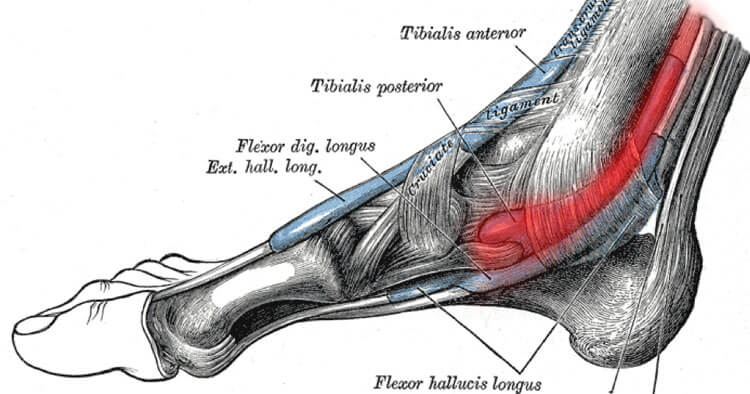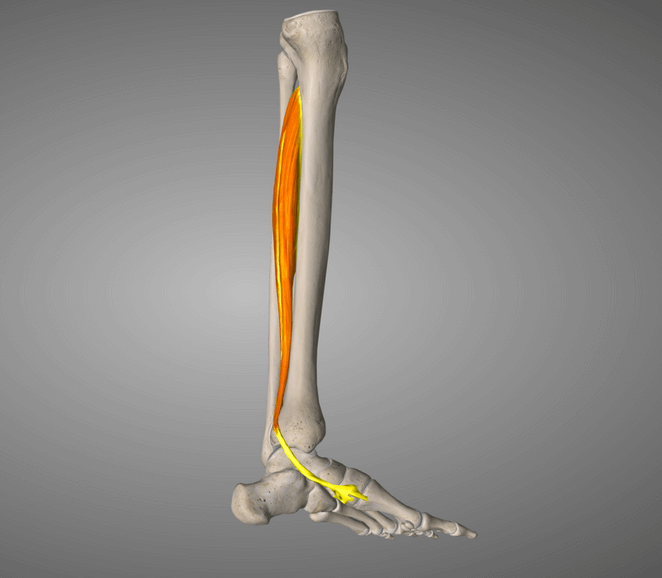Muscle Pain and Tendinopathy
Spotlight On Tibialis Posterior
The Anatomy Of The Tibialis Posterior Muscle
The tibialis posterior muscle commonly referred to as “tib post”, may just be one of the most important muscles in the body that you have never even heard of till now. Your “tib post” is a muscle that sits in the lower leg where the majority of the muscle originates from the medial surface of the posterior tibia (which is the larger of the shin bones positioned on the inside of the lower leg) and lies deep and medial to your large calf muscles the gastrocnemius and soleus. As can be seen in the diagram below the tibialis posterior muscle from its origin runs down the medial shin, where as a tendon passes behind the medial malleous of the ankle (the bottom bump of the tibia) before inserting to a number of bones in the arch of the foot. In particular tibialis posterior has its main insertion onto the navicular bone, which is one of the small tarsal bones making up the mid foot.
The Function Of The Tibialis Posterior Muscle
The basic action of tibialis posterior is to plantarflex, which in the foot is the anatomical name for the action of pointing the ankle and toes of the foot downwards, and the other role of “tib post” is to invert the foot and ankle, which itself is the action by which the foot is turned inwards towards the other foot. However, functionally beyond having the ability to assist and create these basic movements of the foot and ankle “tib post” plays a crucial role in maintaining the medial longitudinal arch of the foot and controlling both the amount and rate of pronation of the foot. Where pronation is an action where the arch on the inside of the foot is seen to drop down towards the ground. Tibialis posteriors role in the controlling the main arch of the foot makes it a vital muscle in maintaining lower limb biomechainics when weight baring including walking, running or any activity where you are loading through the foot. Making “tib post” a crucial muscle in both daily life and many sporting endeavors.
Injuries To The Tib Post
Muscle strains of “tib post” are not overly common, however overloading to and the experience of pain within the tendon complex, either the body of the tendon, tendon sheath, the origin of the tendon at the muscle tendon junction, or the insertion of the “tib post” tendon to the navicualr or any of the other foot bones are not uncommon.
Medial tibial stress syndrome, regularly referred to as shin splints is one such injury afflicting runners involving the tibialis posterior muscle and tib post tendinopathy is another.
- “Shin splints” tends to occur mainly in runners, or athletes with high running loads in their chosen sports. Where as “tib post” tendinopathies occur in a more varied population not just affecting the athletic .
- It is not uncommon for a “tib post” tendinopathy to develop post traumatically, such as following ankle sprains or fractures, or from overload with sporting endeavors. As with many tendon overload complaints, tib post tendinopathy increases in prevalence with increasing age and is more likely to give someone issues in their forties and fifties, around this age issues involving “tib post” often seemingly arise without any significant trigger.
Disclaimer: Sydney Physio Clinic does not endorse any treatments, procedures, products mentioned. This information is provided as an educational service and is not intended to serve as medical advice. Anyone seeking specific orthopaedic advice or assistance on Spotlight On Tibialis Posterior should consult his or her general practitioner, sports medicine specialist, physiotherapist or otherwise appropriately skilled practitioner.



